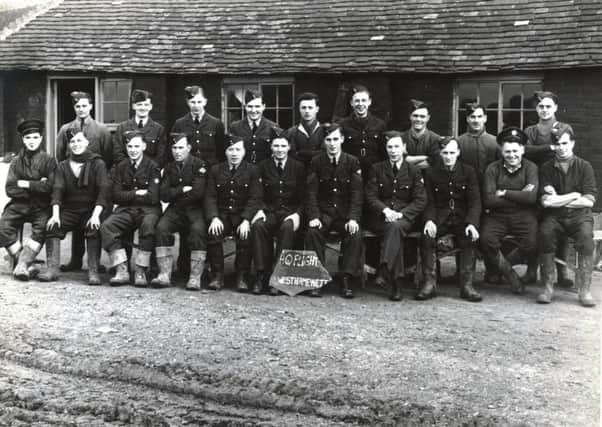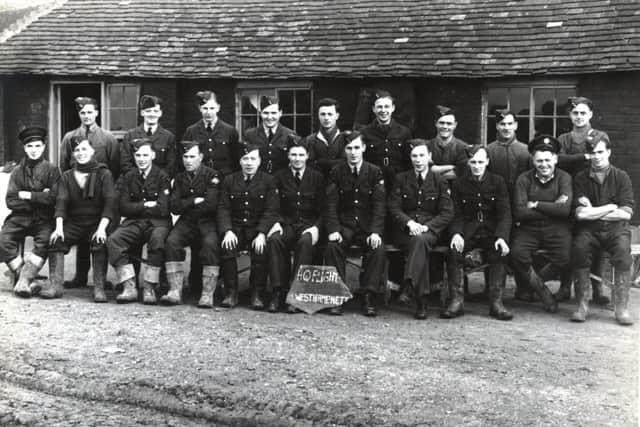Battle of Britain: How Goodwood helped to win the battle for the skies


“Having taxied in, we began to get the feeling of our new surroundings. Our predecessors, 145 Squadron, flying Hurricanes, had lost twelve of their aircraft destroyed, with eleven pilots killed, in the three days 8th, 11th, and 12th August [1940].
“On the 12th, the day prior to our arrival, 512 enemy ’planes had been plotted on radar. 145 Squadron had, I recall, only four pilots left and they were forthwith despatched to Dyce in Scotland for recuperation.”
Advertisement
Hide AdAdvertisement
Hide AdPilot Officer Rose was one of ‘The Few’ of RAF Fighter Command, who in 1940 was flying with 602 (City of Glasgow) Squadron and based at RAF Westhampnett, now known as Goodwood airfield.


Even as late as 1938, Goodwood was literally a field with no purpose-built facilities other than a windsock – the latter serving as a reminder of the airfield’s pre-war link with aviation through the 9th Duke of Richmond.
Frederick Charles Gordon Lennox, the 9th Duke of Richmond, Lennox, Gordon and Aubigny (1904-1989), had been a keen aviator.
He not only designed and flew his own aircraft, but developed his own flying field to the south of Goodwood House, complete with a thatched hangar to house his aircraft.
Advertisement
Hide AdAdvertisement
Hide AdThe status of the airfield changed just prior to the Battle of Britain when it was upgraded to serve as a satellite airfield of nearby Tangmere and grass runways were laid out.
Only then did some basic facilities start to appear, amongst which was a Watch Office. Generally speaking though, throughout the early stages of the war there was a distinct lack of facilities.
Aircraft were often maintained and serviced in the open, whilst airmen slept in tented accommodation – although the officers were initially accommodated in relatively luxurious surroundings, initially at Woodcote Farm then Shopwyke House.
The two cottages that stood within the airfield boundary (both of which are still standing) were quickly put to good use, as were many surrounding buildings, accommodating, for example, the NCO pilots and cooking/messing facilities.
Advertisement
Hide AdAdvertisement
Hide AdBy the time 145 Squadron left Westhampnett mid-way through the Battle of Britain (it was the first squadron based there), at which point Nigel Rose’s 602 (City of Glasgow) Squadron arrived, at least two flight huts had been constructed.
That for ‘A’ Flight was located by the northernmost cottage on the airfield opposite Woodcote Farm and along the Lavant Straight of the racecourse. ‘B’ Flight, on the other hand, was situated by the Vitrae Café, or the old control tower, along the eastern boundary following the road back to Chichester.
Having found itself on the front line of the air war over southern Britain, the pilots of 602 Squadron, which was equipped with Spitfire Mk.Is, did not to wait long for their baptism of fire.
Nigel Rose continues and gives an insight as to what it was like for a Battle of Britain pilot: “The fine summer of 1940 made for days that seemed so long. The morning call to ‘flights’ could be as early as 4 a.m and sometimes a scramble would mean taking off in a blanket of mist, above which the only point of reference was the spire of the Cathedral bathed pink in the rising sun.
Advertisement
Hide AdAdvertisement
Hide Ad“For a green pilot, just joined the squadron … it was an awesome sight. To see the serried ranks of hostile aircraft, made all the clearer at times by being silhouetted against a blanket of white cloud.
“The Commanding Officer would divide the squadron so that one flight was allocated to the fighters, one to the bombers. If the bombers were slower and easier targets, they still had the protection of their turret gunners. More often than not in 602 we seemed to find ourselves tangling with the fighter escort.
“Having selected your target, you would turn your gun button on the control column to ‘fire’ and the next most important action was to ensure as best you could that you were not being targeted yourself!
“The instant reaction if you were being attacked was to go in to the steepest turn you could manage to try and get on the attacker’s tail. This would usually mean losing consciousness temporarily.
Advertisement
Hide AdAdvertisement
Hide Ad“Or you could turn on your back and dive right out, twisting and turning this way and that. Such a manoeuvre doesn’t sound very brave, but sometimes to run away allowed one to live and fight another day!
“On levelling out from a 400mph dive it was quite astonishing how empty the sky was and often not a ’plane to be seen. Occasionally in the middle of a chaotic scrap, a [Messerschmitt] Bf 109 or 110 would flash past you going in the opposite direction with breath-taking closing speed.
“There was little time to do anything but gawp and say a little prayer.”
After the hectic combats of the Battle of Britain, Westhampnett then became the base of Wing Commander Douglas Bader, until he was shot down over France, as Fighter Command took the war to the enemy with sweeps over Occupied Europe.
Advertisement
Hide AdAdvertisement
Hide AdThe airfield also played its part in the Dieppe Raid and, in due course, the D-Day landings and Operation Market Garden at Arnhem.
By the end of the war, RAF Westhampnett had been extensively developed. It had been home to at least forty-six squadrons and sub-units, some of the squadrons being based at the airfield more than once.
It had been the base of French, Canadian, American, Polish, New Zealand, and Belgian squadrons, and resounded to the noise of Hurricanes, Spitfires, Typhoons, Tempests, Mustangs, Barracudas, Avengers and Tigercats, amongst many others – although the local residents were not too keen on the noise produced by the Typhoon with its twenty-four cylinder Napier Sabre engine!
Written by local author Mark Hillier, who also flies from Goodwood today, a new book by Frontline Books charts the growth and changes that Westhampnett experienced throughout the war and reveals the main actions that the squadrons based there were involved in.
Advertisement
Hide AdAdvertisement
Hide AdPacked with more than 250 wartime photographs and accompanied by a detailed history of the fighting as seen through the eyes of many of the surviving pilots and ground crew, A Fighter Command Station at War not only brings to life those exciting but dangerous days, but helps to ensure that one airfield’s role in the Second World War is not forgotten.
To follow our live blog click here
Don’t miss out on all the latest breaking news where you live.
Here are four ways you can be sure you’ll be amongst the first to know what’s going on.
1) Make our website your homepage
2) Like our Facebook page
3) Follow us on Twitter
4) Register with us by clicking on ‘sign in’ (top right corner). You can then receive our daily newsletter AND add your point of view to stories that you read here.
And do share with your family and friends - so they don’t miss out!
Always the first with your local news.
Be part of it.